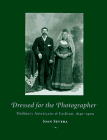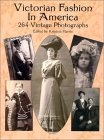In June 1830 the
'Lady‘s Book' was published by Louis Antoine Godey (1804-1878) in the USA and it evolved from a magazine that was largely made up out of cuttings from English magazines into a woman's magazine. It included articles, editorials, literary notices, needlework patterns and later fiction by Edgar Allen Poe, Harriet Beecher Stowe and Longfellow accompanied the illustrated fashion reports. In 1837 the name was changed to
Godey's Lady's Book and the editor Sarah Josepha Hale (1788-1879) promoted woman's domestic education but not their political awareness. By 1858 it had a circulation of 150,000 copies and influential in guiding the fashions of the day through the use of colored fashion plates. Godley sold the magazine in 1877, one year before his death, and the magazine was eventually merged into another publication. The reason why this magazine was so important was that it had a format that would be copied time and time again as fashion magazines with photographs emerged.
| Nineteenth century color fashion plates |
|
The early magazines that dealt with fashion in both Europe and North America evolved out of more general publications on woman's issues which were essentially those of home making, self education and needlecraft but with the growth of an increasingly affluent middle class brought about by industrialization there was a need for cultural information. To say that the needs for nineteenth century women were fashion magazines would be trivializing and over-simplifying the situation but they found their readership in the large group of woman where social conditions meant that working outside the home was not regarded favorably.
Magazines arose to provide fashion information in different parts of the world:
- France
French fashion publications - Les Modes Parisienne, Le Monde Elégant
- Germany
Modenwelt, Firmin-Didst, and Der Bazar
- USA
Following the success of Godey's Lady's Book in 1867 Harper's Bazar was founded and later changed its name to Harper's Bazaar and it is seen as America's first significant fashion magazine. During the early years of these publications copyright was not a significant issue and they regularly used illustrations from European magazines. The Delineator, A Monthly Magazine (1873-1937) was another major American fashion magazines with a circulation in 1900 of 480,000. The success led it to have French, German, and Spanish editions. Vogue was founded in 1892 but its rise to the zenith of fashion publication was largely following its purchase by Condé Nast in 1909. There were a number of others which are long forgotten such as Elite Styles (1897-1929) or Pictorial Review (1899-1939) but some have endured such as McCall's Magazine that was started in 1897.
| Dressed for the Photographer: Ordinary Americans and Fashion, 1840-1900 | Dressed for the Photographer: Ordinary Americans and Fashion, 1840-1900
Joan L. Severa; Nancy Rexford; & Claudia Brush Kidwell |  |
|
| |
| Victorian Fashion in America: 264 Vintage Photographs | Victorian Fashion in America: 264 Vintage Photographs
Kristina Harris (Editor) |  |
|
|
It was only with the development of the halftone process in 1886 that it became practical to print photographs and text on the same page and this had considerable implications for magazine photography although it took time to be accepted. It was used in
La Mode pratique in 1892 but it was not until the first decade of the twentieth century that it gained general acceptance.
Fashion photography had tended to consist of portraits of the famous and the photographic studios that took the photographs, such as Reutlinger in Paris, were also involved in photographing the stars of theatre, music and the French social elite. Indeed it was similar to contemporary fashion with stars being asked to model designer gowns in much the same way that designers and jewelers get stars to display their wares at the Academy Awards. The settings, lighting and poses of early fashion photographs were essentially identical to those of contemporary portrait photographers.
| Photographs of costumes (1839-1860) |
Research into fashion trends prior to 1900 relies heavily upon the engravings found in the magazines as photographs were not commonly used in magazines before that.
Photographs were rarely taken as a conscious process to preserve fashion details but they have come to be highly prized by those interested in the historical costumes as a reliable source of information. The examples here illustrate different clothing styles. | | [Checklist] | Click on image for details
[Copyright and Fair Use Issues] |
|

